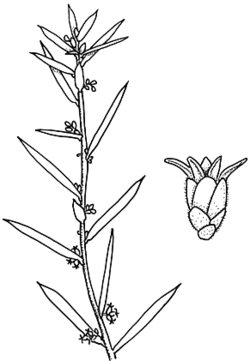Monotoca scoparia (Sm.) R.Br. APNI* Synonyms: Styphelia scoparia Sm. APNI*

Description: Compact to spreading shrub, usually 30–120 cm high, lignotuber present; branchlets scabrous.
Leaves erect to spreading, narrow-oblong or narrow-elliptic, usually 6.6–15 mm long, 1–2.6 mm wide; margins entire or minutely toothed towards apex; lamina glabrous and discolorous, upper surface ± convex, lower surface 3–5 striate-veined and often glaucous; petiole 0.5–1.6 mm long, scabrous.
Flowers axillary, usually in 2–5-flowered spikes, white; peduncles 1–2 mm long; bracteoles 0.7–1.1 mm long. Sepals 1–1.9 mm long. Corolla tube campanulate, 0.9–2.6 mm long, glabrous; lobes 0.8–1.5 mm long, glabrous or papillose.
Fruit ovoid to oblong, 2.8–3.1 mm long, yellow to orange.
Flowering: March–June.
Distribution and occurrence: Grows in dry sclerophyll forest, woodland and heath on sandy soil, widespread, west to Bunberry near Molong.
NSW subdivisions: NC, CC, SC, NT, CT, ST, NWS, CWS
Other Australian states: Qld Vic. Tas. S.A.
Populations on the CWS differ in being more robust, taller shrubs, 110–300 cm high with flatter larger leaves (11.6–23 mm long and 2.1–2.8 mm wide), with acute base and entire margins. Peduncles are longer (1.5–3 mm) and the sepals ciliate rather than minutely ciliate. These may warrant distinction at subspecific rank.
Text by J. M. Powell, except for groups with contributors listed
Taxon concept: Flora of NSW 3 (1992)
ECOLOGY
Life History
Vegetative spread No (McIntyre et al. 1995).
Longevity Medium--long.
Flowers White, March--July, peak April--May. Large-flowered plants visited by introduced bee, small-flowered plants by by little black native bee (I. Bowden Herbarium note).
Fruit/seed Fleshy fruit (drupe), average fresh weight 7 mg (J. Howell pers. comm.), 3 mm long, yellow--orange, mature December--June.
Dispersal, establishment and growth Diaspore: fruit, adapted for dispersal by ingestion (McIntyre et al. 1995), both vertebrate and ant-adapted dispersal (Westoby et al 1990). Myrmecochore (Rice & Westoby 1981).
Fire response Stems killed, regenerates from basal sprouts (e.g. at Agnes Banks (Benson 1981), after high-intensity fire at Katandra 1/1994, L.McD.). No seedlings recorded less than 1 year after fire (Purdie 1977). A few resprouting plants flowering within 17 months of high intensity fire (at Lane Cove River & Narrabeen Lake 1/1994, P. Kubiak pers. comm.).
Interaction with other organisms Foodplant of butterfly larva Neolucia mathewi (Common & Waterhouse 1982) and moth larvae Poecilasthena pulchraria (Common 1990). Low palatability, mortality unaffected by grazing after fire (Leigh & Holgate 1979).
Habitat
Habitat Ridges, hillslopes.
Altitude 0--1000 m
Annual rainfall 700--1600 mm
Typical local abundance Frequent--occasional.
Vegetation Eucalypt forest, woodland e.g. with Eucalyptus piperita, E. sieberi, E. blaxlandii, E. oreades, E. dalrympleana, E. pauciflora, E. rossii, Corymbia eximia, Angophora costata, Eucalyptus agglomerata, and occasionally heath.
Substrate Sandy loam soil, over sandstone, conglomerate, sand dunes, low nutrients.
APNI* Provides a link to the Australian Plant Name Index (hosted by the Australian National Botanic Gardens) for comprehensive bibliographic data
***The AVH map option provides a detailed interactive Australia wide distribution map drawn from collections held by all major Australian herbaria participating in the Australian Virtual Herbarium project.
|


